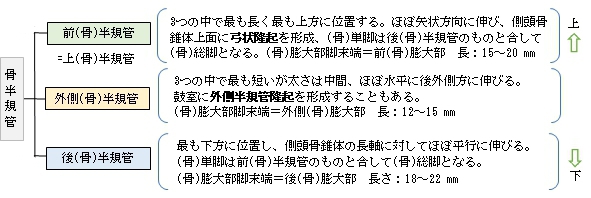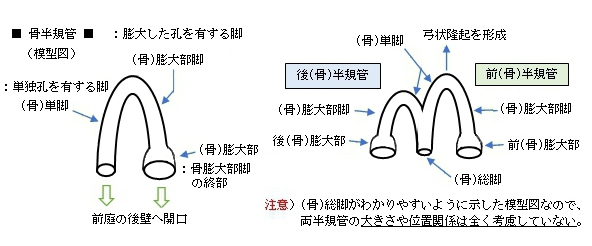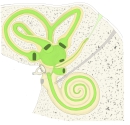
・「その湾曲面は側頭骨錐体の長軸に平行してほぼ前頭方向に位置する。」(日本人体解剖学)






|
|
|
|
骨迷路・膜迷路 |
骨迷路 |
骨迷路 |
迷路と神経 |
|
|
|
|
外リンパ腔・膜迷路 |
|
|
|
「 日本人体解剖学 」では以下のように解説している。
「長さ、湾曲度、太さいずれも他の2管にまさり、その湾曲面は側頭骨錐体の長軸に平行してほぼ前頭方向に位置する。その膨大端を後(骨)膨大部といい前庭の後下部に開通し、反対端の(骨)単脚は前(骨)半規管の短脚と合して(骨)総脚をつくる。」
以下は「Wikipedia」の解説文となる。
The posterior semicircular canal is a part of the vestibular system that detects rotation of the head around the antero-posterior (sagittal) axis, or in other words rotation in the coronal plane. This occurs, for example, when one moves the head to touch the shoulders, or when doing a cartwheel.
It is directed superiorly, as per its nomenclature, and posteriorly, nearly parallel to the posterior surface of the petrous bone. The vestibular aqueduct is immediately medial to it. The posterior canal is part of the bony labyrinth and is used by the vestibular system to detect rotations of the head in the coronal plane. It is the longest of the three canals, measuring from 18 to 22 mm (0.71 to 0.87 in). Its lower or ampullated end opens into the lower and back part of the vestibule, its upper into the crus commune.
【 語 句 】
・vestibular system:前庭系? ・detect:検出する ・sagittal:矢状の ・axis:軸 ・coronal plane:冠状面 ・carwheel: ・be directed:向いている ・nomenclature:学名 ・petrous bone:錐体骨 ・crus commune:(骨)総脚
■ 写真やイラストを掲載しているサイト ■
・ イラストや写真を掲載しているサイト-Ⅰ
・ イラストや写真を掲載しているサイト-Ⅱ
・ イラストや写真を掲載しているサイト-Ⅲ
・ イラストや写真を掲載しているサイト-Ⅳ
・ イラストや写真を掲載しているサイト-Ⅴ
